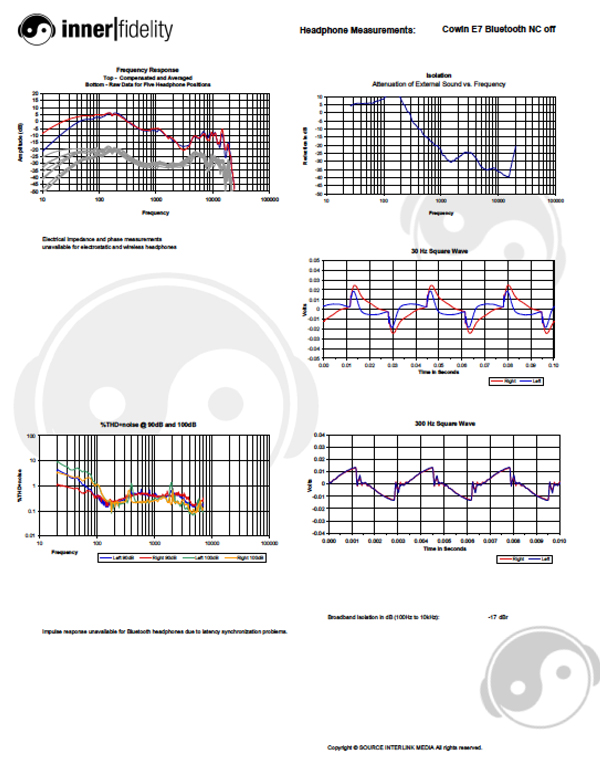| Columns Retired Columns & Blogs |
Amazon's Top Selling Cowin E7 Wireless Noise Canceling Headphones Measurements
Measurements Wired NC Off


Click on graphs image to download .pdf for closer inspection.
Click on graphs image to download .pdf for closer inspection.
Because of their similar performance I'm grouping noise canceling and non-noise canceling modes together for discussion.
Raw frequency response plots with NC off show significant changes in bass response with positional changes on the head. Bluetooth mode looks significantly worse, my guess is that's just the luck of the draw. These were difficult to get a good seal on the dummy head.
Bass response shows a large, 10dB boost centered at around 170Hz with a fairly rapid fall-off below. These were definitely bloated sounding. Midrange response above 500Hz isn't too bad but the peak 5-6kHz should be lower at about 3kHz; subsequent response above 4kHz falls off at a reasonably good rate and is devoid of any sharp peaks. This produced a zingy, but listenable, treble response.
30Hz square wave is strongly misshapen indicating significantly non-flat and phase shifted bass response. Coupled with the significantly rising bass distortion below 200Hz and you begin to get a pretty good picture of a headphone with lousy bass.
300Hz square wave is relatively noise-free, but initial overshoot is not high enough and to overall waveform rises significantly, both indicating low treble level.
The impulse response didn't trigger, likely due to too much time/phase shifting through the electronics.
THD+noise plot are worse than average below 200Hz, but pretty good above. I did here the response above 200Hz, though uneven, as fairly clean.
Impedance plots show a 9 kOhm nominal headphone indicative of the input impedance of the electronic circuits. Isolation is about average for a sealed, over-ear headphone. Needing 68mVrms to achieve 90dBspl at the ear these cans will play plenty loud from a portable device.
Click on graphs image to download .pdf for closer inspection.
Click on graphs image to download .pdf for closer inspection.
The picture changes significantly with noise canceling on. The noise canceling servo flattens out the big bass bump and extends (sort of) the low bass, but also creates a large response hump centered between 400Hz and 1kHz. This creates a strong midrange shouty response in listening. Treble response rises in level after a trough in the presence region (1-3kHz) that, fortunately, prevents these cans from too much resembling a land line telephone call.
30Hz square wave is all but unreadable. The large forward shoulder of the 300Hz square wave indicates the midrange emphasis seen in the raw response.
THD+noise shows bass with less distortion than non-NC mode indicating the NC servo tends to correct the bass distortion present in the non-NC mode. Overall curve is higher than non-NC mode probably due to noise from the electronics circuitry.
Isolation plots show kicking in at 400Hz and below providing roughly 15dB more isolation than without noise canceling.
Phew! Glad I'm done with these.
- Log in or register to post comments







































